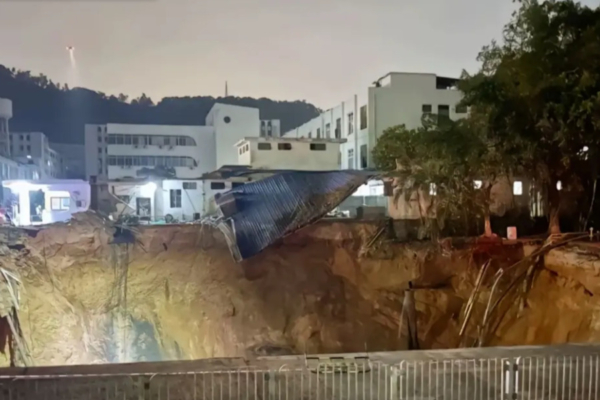On December 6, 2024, the collapse of the Shenzhen Shenjiang Railway in China resulted in 13 workers being missing. Some experts believe that the collapse accident may be related to soil erosion, but misjudgment by the construction site team could also be one of the reasons.
Around 11:00 PM on December 4, a sudden ground collapse occurred at the construction site of section 5 of the Shenjiang Railway. As of 10:00 AM on the 5th, 13 workers were reported missing. According to Ming Pao, the collapse site is located at the entrance of Baozhou Industrial Park on Zhou Shi Road, less than 500 meters away from Shenzhen’s largest Tangang Reservoir.
After the collapse of the construction site, a large pit with a diameter of over 30 meters and a depth of about 10 meters appeared, with water seepage.
Witnesses reported to local media, “It’s really a huge pit, houses have collapsed, and looking at this pit I feel scared, I’m only 10 meters away from it.” Some internet users mentioned, “Right beside me, the natural gas in my shop has been cut off.”
Another netizen commented in a video that the collapse occurred at Zhou Shi Road (at the entrance of Baozhou Industrial Park), which is a two-way road, with both sides of the road and the entrance of the industrial park collapsing severely, affecting three nearby industrial areas, especially Baozhou.
Due to concerns about further collapses, authorities evacuated nearby residents on the afternoon of the 4th and closed off surrounding roads.
An emergency notice circulated online from a local community stated that on the afternoon of the 4th, the project team of section 5 of the Shenjiang Railway reported that after blasting operations were carried out 45 meters underground, quicksand was discovered, prompting the closure of the road above the operation site.
According to Caixin, some residents received evacuation notices on the afternoon of the 4th, with the area around the accident site being sealed off around 4:00 PM, but collapses continued to occur, leading to the disappearance of workers at 11:00 PM.
However, as of now, there has been no progress in the rescue operation. According to the State Council of China’s “Regulations on Reporting and Handling of Production Safety Accidents,” accidents resulting in the deaths of between 10 and 30 people are considered “major accidents.”
The Shenjiang Railway connects the two cities of Shenzhen and Jiangmen in Guangdong Province, with a total length of 116 kilometers. The project is implemented in 5 sections, with section 5 of the Shenjiang Railway, where the collapse occurred, being 20.06 kilometers long and built by China Railway 4th Bureau.
Sources indicated that the incident location is suspected to be the connecting line of the Shenjiang Railway’s Shenduan Tunnel. The Shenduan Tunnel connecting line reportedly applies a construction method combining drilling and blasting with shield construction.
Caixin quoted experts in the engineering field as saying that during the project construction, encountering quicksand led to the collapse when emergency measures were taken.
A senior figure in the Guangdong construction industry told Ming Pao that this collapse is likely due to soil erosion, with signs that were not responded to promptly to assess subsidence conditions, resulting in the tragic incident of burying people.
A railway construction practitioner mentioned that the high probability of collapses in construction accidents in southern cities is likely due to geological reasons, and this incident could be related to inadequate construction monitoring and response.
The accident has caused anxiety among local residents, with many netizens expressing concerns such as, “Shenzhen has many mountains, a long rainy season, and has been digging a lot in recent years.” “Bao’an in Shenzhen is always burying people.” “Seventy-plus people were buried in landslides in the past 15 years.” “Development leads to destruction, the underground has been hollowed out, collapses happen here today, and there tomorrow, disasters can strike at any moment, it’s all a matter of luck to survive.”

